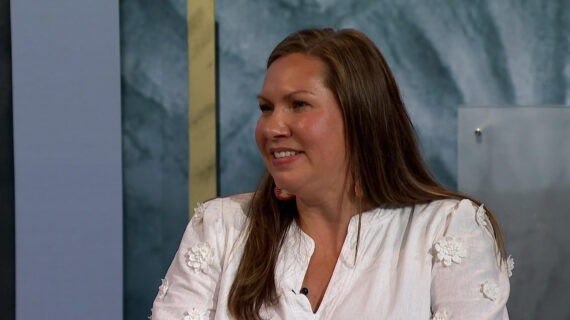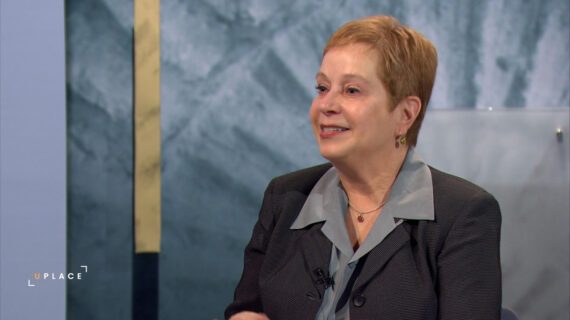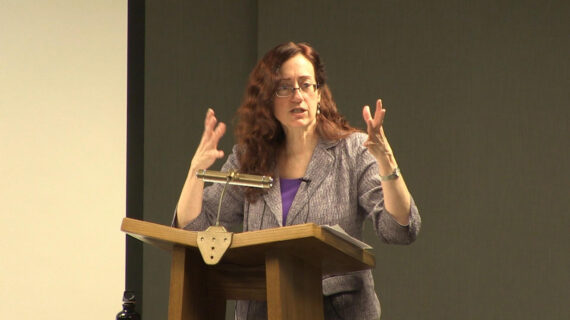Marisa Wojcik:
Welcome to Noon Wednesday. I’m Marisa Wojcik, a multi-media journalist with Here & Now, on Wisconsin Public Television. I want you to imagine for a moment that you’ve just been released from jail. You’ve paid your debt to society, but now you have to pay your debt to the jail. So, Dee Hall, from the Center for Investigative Journalism is here to talk to me about what this looks like in Wisconsin. So, Dee, thanks so much for being here.
Dee Hall:
Thanks a lot for having me.
Marisa Wojcik:
So, this is commonly referred to as Pay to Stay.
Dee Hall:
Yes.
Marisa Wojcik:
What does that mean?
Dee Hall:
So, Pay to Stay is actually a fee that is charged by some counties in Wisconsin and the state prison system as well as 39 other states have some form of this in some of their institutions. It is the room and board that the inmate pays for staying in the jail or prison.
Marisa Wojcik:
And, do we know kind of what the average monthly cost is?
Dee Hall:
Well, we, so, at Wisconsin Watch, our reporter, Isabella Zaluska, did a survey of every county Sheriff’s Office, who run the jails, to find out what the charges were, and they range widely from $5 a day to, I believe, $26 a day was the highest. And so when you add that up, an average stay is about 25 days, or almost a month, we’re talking over $300, almost $400 for a typical stay for somebody. And, as you may remember, the fed has done studies about how many people in America could afford an unexpected $400 payment. About 40% of people couldn’t afford that, and, of course, this demographic we’re talking about is even lower income, than a typical person.
Marisa Wojcik:
And, I mean, talking about that, can someone who has been out of work because they are in jail, they possibly lost their job, they are maybe paying for their housing that they’re not staying at while they’re in jail, I mean, it just seems like it would be kind of hard for anybody, let alone someone who is low income. Is that factored in?
Dee Hall:
Well, so, some places do look at your ability to pay and, in some places, the only people who are charged are inmates who are on work release, who are able to go outside the prison walls and earn a market-rate salary. And for those folks, for example, in the state prison system, the charge between the room and the board and the transportation can be as much as $750 a month. So, yes, it’s a large amount of money, and entire advocacy groups have grown up around opposing this because they see this as detrimental to the re-entry of individuals who are already, who probably, as you said, have already lost a job. They’re probably not, they don’t have much income, anyway to begin with, and then, suddenly, they have this giant debt. One of the studies that Isabella quoted in our story was a very interesting finding that there was a certain percentage, I think bout 1/3 of people who had been released from prisons in Louisiana had reported actually committing another crime to pay back the fees that they had racked up while they were in jail. So, clearly not a rehabilitation method, at least according to the critics.
Marisa Wojcik:
And the UW Madison Institute for Research on Poverty had their own, kind of, fact sheet about this thing that Pay to Stay fees are disproportionally burdensome to low income people, and your story begins with a man who was charged with $20 a day, and he calls it a vicious cycle, and says that you’re in a worse financial state than when you entered prison. So does it, does it snowball? Does it get out of hand? Are people finding themselves further in debt?
Dee Hall:
Well, in this case, so this was an inmate named Shawn Pugh, and he was about a year and a half into a probation slash extended supervision hold meaning. He had been released from prison, he was supposed to live under terms of that release, there was an allegation, later confirmed by DOC that he had done something to violate that. But, while they were, in fact, trying to figure out if he had, in fact, violated the terms of his release, he was actually incarcerated for almost 2 years, at $20 a day. And it wasn’t until about a year and a half into his stay that he realized that he had racked up a Pay to Stay bill of $17,000 over that stay, and some previous stays in the Brown County Jail.
Marisa Wojcik:
And, he, in particular, was able to fight these charges, but that’s not the story for the average person.
Dee Hall:
So, so, yes, I mean, he was able to fight the charges and ended up in a settlement with the Brown County Jail. But, no, there are tens of thousands, hundreds of thousands of dollars that, in fact, are being collected around the state. One county Isabella found actually had, I think, about 950 thousand dollars in fee revenue from these types of fees.
Marisa Wojcik:
And, on top of that, the story that Isabella reported also goes into, kind of like Shawn Pugh, he’s being charged for things that are before incarceration, during incarceration, and then, also after incarceration, with like, electronic monitoring, and there’s all sorts of other fees, so, in the end, these pile up pretty fast.
Dee Hall:
Right, so, inmates are charged, not only for the Pay to Stay, and GPS monitoring, that can be very expensive, hundreds of dollars a month. In addition to that, they have to pay for phone calls, some of those are predatory rates, there’s been a lot of news coverage of that. They even have to pay to go to the doctor or to the nurse to have a visit with the doctor or nurse, in some cases, it’s a nominal fee. In other cases, it might be prohibitive, over $50. When you add all of that up, it can be a pretty hefty bill. And, again, we’re dealing with people, who, according to the Prison Policy Project, are earning something in the category of like $19,000 a year. So these are people who are basically poor, on average, who are being charged very high fees in some cases.
Marisa Wojcik:
Do we know what happens if they don’t pay their bill? Is it kind of, like, in the medical system, you know, the hospital can write it off, or they can get away with not paying their bill? Or does that mean they are more likely to be sent back to prison because they haven’t been paying their debt?
Dee Hall:
So, that does not seem to be a practice in Wisconsin. It has been a practice in other states. And we did not, one thing we did not look at, was the collection practices of the various counties. So, I don’t really know how aggressive they are trying to get these fees back. I do know, as somebody just sort of lives in the world, that if you have a debt that’s on your record, of $10,000 that you didn’t pay, that makes it very difficult to buy a car, to buy a house, to get a credit card, at a reasonable rate, and many other effects of having a poor credit score.
Marisa Wojcik:
So, like, it’s following the regular capitalist system?
Dee Hall:
Or, you know, even just getting an apartment, you know. You know, landlords will look at your credit score, and if you’re somebody who’s got this giant, outstanding debt, it may be the case that they don’t want to take a chance on you.
Marisa Wojcik:
And, so, some people who are against these Pay to Stay fees are arguing that these excessive bills can be a violation of Constitutional rights. How so?
Dee Hall:
Well, so, there is a Constitutional prohibition against excessive fees and fines. That’s been litigated on the federal level. And then recently the US Supreme Court said, even though it’s part of the federal constitution, that it could, it may very well violate the federal constitution if states impose these kinds of fees. And, there was a US Supreme Court decision, and Clarence Thomas was one of the, either he wrote the opinion, or he joined in the majority opinion, which I think was unanimous, noting that we have, for almost our entire history, have had this prohibition against excessive fees and punishments. For example, we would consider it absurd that you would have the death penalty for littering, right? So, it’s kind of well recognized in our law and in our tradition that you don’t expose people to these excessive fees, fines and punishments. And, so, this had been, there’s no benchmark, in terms of what is excessive right now, but there are states that are looking at this. And, for example, New Hampshire just recently repealed its Pay to Stay law, and I’m not sure what the basis for repealing it was, but, in essence, this is becoming something that people are starting to talk about as potentially, you know, working against rehabilitation and re-entry.
Marisa Wojcik:
And, the arguments for say that, you know, the financial need is there because people are committing crimes, and, therefore, they’re being sent to jail, and, therefore, the need is there. But, also, they think it’s a deterrent for
Dee Hall:
Right
Marisa Wojcik:
People to commit crimes. Shawn Pugh wasn’t even aware of the debt that he was racking up. I mean, do these arguments hold water?
Dee Hall:
Well, so, in terms of the deterrent, I would say that his case is not unusual. When Isabella did the survey, and, she got, I think half, 60 counties, in the end, she was able to gather information from 60 of over 72 counties, but it was through a lot of effort. Some of the counties answered the survey she sent out, so she got information right away, some of them had it on their website, but in many cases, she had to make phone calls and emails to try and extract the information. So, if you’re just out there as a regular person, you don’t really know that your jail, unless you’ve been there many times, let’s say, has a Pay to Stay fee. So, as a deterrent, it’s not working all that well, unless we were to start publicizing it widely as a deterrent. But, right now, it’s really hard to find out in many cases who’s got the Pay to Stay fee, how much it is, and to what extent you would be subjected to it if you were arrested.
Marisa Wojcik:
And, the other argument, saying that, you know, the need is there. One person quoted in the article says that the Justice System serves everyone, and Wisconsin jails that are run by these counties are public, not private, and, so aren’t our taxes going to pay these fees, and not from the inmates themselves?
Dee Hall:
Right, and so, there’s always that balance. In how to balance your budget, do you do it, you know, for example, a university, they have revenue streams that include tuition, so how much of the costs should you put on students, who are the ones using the institution, how much should you put on taxpayers, how much should you try and get from other sources, like federal grants, and jails are in the same situation. It’s like, OK, you get some money from the state for housing some of these folks, you know, you get money from your county, which primarily relies on property taxes, sometimes sales tax, and then, this is another revenue stream. Many counties have decided not to go that way, but there are at least 23 in Wisconsin that have made the choice to go that direction.
Marisa Wojcik:
And, so, overall the report that the Center puts out, also said that these fees are increasing quite rapidly, of recent years. And, so, do we know what is causing that increase in fees and why it’s becoming a little bit more serious to pay attention to, especially now?
Dee Hall:
Yeah, I don’t know if the fees themselves are increasing but the use of the fees in different jurisdictions, and, I think it probably comes down to money. That’s not something we ask, why did you institute these fees? We ask, did you institute them, and where does the money go? Most of it goes to jail operations. But, you know, there’s no doubt that we have seen incarcerations spike in this country over the past several decades. That means it costs, you know, each state, each municipality, each county is paying a lot more now for incarcerating people than they did, let’s say, 20 or 30 years ago. It’s not unusual for them to look for a revenue source, and this is one that they’ve hit on. It is controversial, though. There are people who believe that we shouldn’t have those.
Marisa Wojcik:
And, again, the UW Madison Institute for Research on Poverty says that high rates of incarceration are a part of what’s driving these up, and putting a strain on local budgets, and taxes. But, they say, you know, reducing jail stays is what is going to kind of reduce this escalation for everyone across the board. Is it that simple, and are policy makers in Wisconsin looking at this from a financial arena?
Dee Hall:
Well, so, I would say that under Gov. Walker, it was not a priority to look at incarceration and the size of the prison population. Now, the new Gov. Evers has said he would like to, ideally, reduce the prison population by 50%. There’s been no specific plan rolled out that way, but one way you could do it, one way Isabella also did an earlier story on that question, one way you could do it and have a big impact is to reduce the time, the number of people who go back on these revocations, you know, they’re out, they’re in the community, they allegedly have committed a rule violation. 40% of the people who come into the jails and get sent back to prison, are there, not for committing a new crime, but they’re there for rule violations. So that’s one way that I know that the Evers administration is looking at, where they are in that process, I don’t know, but that’s a strategy that’s been pushed by a lot of people that, you know, maybe we just need to be a little slower on the trigger to lock people up whenever you think that they might have violated a rule.
Marisa Wojcik:
Well, as the Evers administration continues on, I’m sure that this topic will come up again.
Dee Hall:
Yes.
Marisa Wojcik:
Thank you so much for being here.
Dee Hall:
All right, thanks a lot. Appreciate it.
Marisa Wojcik:
For more from Here & Now and Wisconsin Public Television, you can visit wpt.org and thank you so much for joining us on Noon Wednesday.
Search Episodes
Related Stories from PBS Wisconsin's Blog

Donate to sign up. Activate and sign in to Passport. It's that easy to help PBS Wisconsin serve your community through media that educates, inspires, and entertains.
Make your membership gift today
Only for new users: Activate Passport using your code or email address
Already a member?
Look up my account
Need some help? Go to FAQ or visit PBS Passport Help
Need help accessing PBS Wisconsin anywhere?

Online Access | Platform & Device Access | Cable or Satellite Access | Over-The-Air Access
Visit Access Guide
Need help accessing PBS Wisconsin anywhere?

Visit Our
Live TV Access Guide
Online AccessPlatform & Device Access
Cable or Satellite Access
Over-The-Air Access
Visit Access Guide
 Passport
Passport


















Follow Us